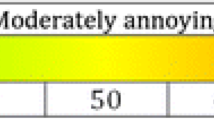Summary
Subjective snoring intensity depends on body position. Unfortunately, there still is no accepted protocol for the objective assessment of snoring sounds. In general, objective data are lacking. This study objectively assessed the influence of the elevated versus the flat position of the upper body on the intensity of snoring. The snoring sounds of a 41-year-old male with primary snoring were recorded for 30 min during 54 consecutive nights in supine and in a slightly upright position with the upper part of the body being raised at a 15-degree angle. The tapes were evaluated by a technician who counted the immaculate snoring events. The number of snoring events was statistically significantly higher in the supine position as compared to the elevated body position (175.3±108.6 vs. 55.6±101.4). The authors conclude that the position of the upper part of the body may influence the severity of snoring.
Zusammenfassung
Die subjektive Intensität des Schnarchens ist abhängig von der Körperlage. Leider gibt es bisher kein allgemein akzeptiertes Protokoll für die objektive Erfassung und Analyse von Schlafatmungs geräuschen. Daher gibt es bislang kaum objektive Daten. Diese Studie befasst sich mit dem Einfluss der Oberkörperposition auf die objektive Intensität des Schnarchens. Die Schlafatmungsgeräusche eines 41 jährigen Mannes mit primärem Schnarchen wurden für jeweils 30 Minuten in 54 aufeinander folgenden Nächten entweder in Oberkörperflachlagerung oder in Oberkörperhochlagerung um 15 Grad aufgezeichnet. Die Tonbänder wurden abgehört und die Anzahl der eindeutig als Schnarchgeräusch zu identifizierenden Ereignisse mit dem menschlichen Ohr ermittelt. Die Anzahl der Schnarchgeräusche pro Stunde war in Oberkörperflachlagerung statistisch signifikant höher als mit erhöhtem Oberkörper (175,3±108,6 versus 55,6±101,4). Die Autoren schließen aus den Ergebnissen, dass die Oberkörperposition einen Einfluss auf die Intensität von Schnarchgeräuschen beim primären Schnarchen haben kann.
Similar content being viewed by others
References
Agrawal S, Stone P, McGuinness K, Morris J, Camilleri AE: Sound frequency analysis and the site of snoring in natural and induced sleep. Clin Otolaryngol 27: 162–166, 2002.
Battagel JM, Johal A, Smith AM, Kotecha B: Postural variation in oropharyngeal dimensions in subjects with sleep disordered breathing: a cephalometric study. Eur J Orthod 24: 263–276, 2002.
Braver HM, Block AJ: Effect of nasal spray, positional therapy, and the combination thereof in the asymptomatic snorer. Sleep 17:516–521, 1994.
Hasegawa M, Saito Y: Postural variations in nasal resistance and symptomatology in allergic rhinitis. Acta Otolaryngol 88: 268–272, 1979.
Höijer U, Ejnell H, Hedner J, Petruson B, Eng LB: The effects of nasal dilation on snoring and obstructive sleep apnea. Arch Otolaryngol Head Neck Surg 118: 281–284, 1992.
Itasaka Y, Miyazaki S, Ishikawa K, Togawa K: Intensity of snoring in patients with sleep-related breathing disorders. Psychiatry Clin Neurosci 53: 299–300, 1999.
Lee BWV, Hill PD, Osbome J, Osman E: A simple audio data logger for objective assessment of snoring in the home. Physiol Meas 20: 119–127, 1999.
Maurer JT, Hein G, Stuck BA, Verse T, Hörmann K: Treatment of obstructive sleep apnea with a new vest preventing the supine position [in German]. DMW 128: 71–75, 2003.
Moerman M, de Meyer M, Pevemagic D: Acoustic analysis of snoring: review of literature. Acta Otorhinolaryngol Belg 56: 113–115, 2002.
Nakano H, Ikeda T, Hayashi M, Ohshima E, Onizuka A: Effects of body position on snoring in apneic and nonapneic snorers. Sleep 26: 169–172, 2003.
Neill AM, Angus SM, Sajkov D, McEvoy RD: Effects of sleep posture on upper airway stability in patients with obstructive sleep apnea. Am J Respir Crit Care Med 155: 199–204, 1997.
Osman EZ, Abo-Khatwa MM, Hill PD, Lee BWV, Osbome J: Palatal surgery for snoring: objective long-term evaluation. Clin Otolaryngol 28: 257–261, 2003.
Osman EZ, Osborne J, Hill PD, Lee BW: Snoring assessment: do home studies and hospital studies give different results? Clin Otolaryngol 23: 524–527, 1998.
Petruson B, Theman K: Clinical evaluation of the nasal dilator Nozovent. The effect on snoring and dryness of the mouth. Rhinology 30: 283–287, 1992.
Runderantz H: Postural variations of nasal patency. Acta Otolaryngol 68: 435–443, 1969.
Schäfer J: A simple procedure for quantitative and time coded detection of snoring sounds in apnea and snoring patients [in German]. Laryngorhinootol 67: 449–452, 1988.
Schäfer J: How can one recognize a velum snorer? [in German]. Laryngorhinootol 68: 290–295, 1989.
Schäfer J, Pirsig W: Digital signal analysis of snoring sounds in children. Int J Pediatr Otolaryngol 20: 193–202, 1990.
Scharf MB, Brannen DE, McDannold M: A subjective evaluation of a nasal dilator on sleep & snoring. Ear Nose Throat J 73: 395–401, 1994.
Sériès F, Marc I, Atton L: Comparison of snoring measured at home and during polysomnographic studies. Chest 103: 1769–1773, 1993.
Smithson AJ, White JE, Griffiths CJ, Prichard AJ, Close PR, Drinnan MJ, Marshall HF, Gibson GJ: Comparison of methods assessing snoring. Clin Otolaryngol 20: 443–447, 1995.
Walker RP, Gatti WM, Poirier N, Davis JS: Objective assessment of snoring before and after laser-assisted uvulopaplatoplasty. Laryngoscope 106: 1372–1377, 1996.
Wittig RM, Romaker A, Zorick FJ, Roehrs TA, Conway WA, Roth T: Night-to-night consistency of apneas during sleep. Am Rev Respir Dis 129: 244–246, 1984.
Author information
Authors and Affiliations
Corresponding author
Rights and permissions
About this article
Cite this article
Verse, T., Pirsig, W., Maurer, J.T. et al. Influence of elevated versus flat upper body position on objective snoring intensity. A case report. Somnologie 8, 151–154 (2004). https://doi.org/10.1111/j.1439-054X.2004.00031.x
Received:
Accepted:
Issue Date:
DOI: https://doi.org/10.1111/j.1439-054X.2004.00031.x




